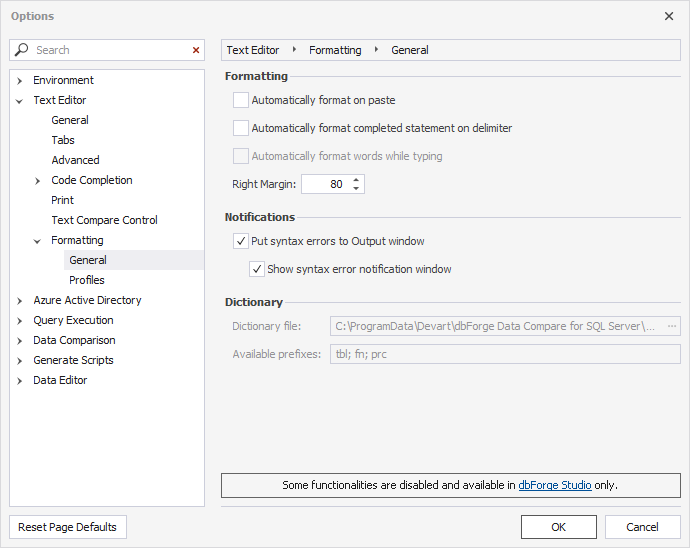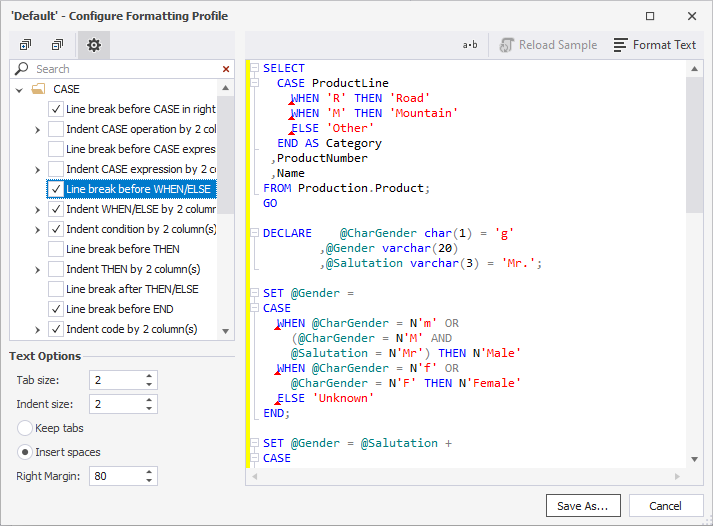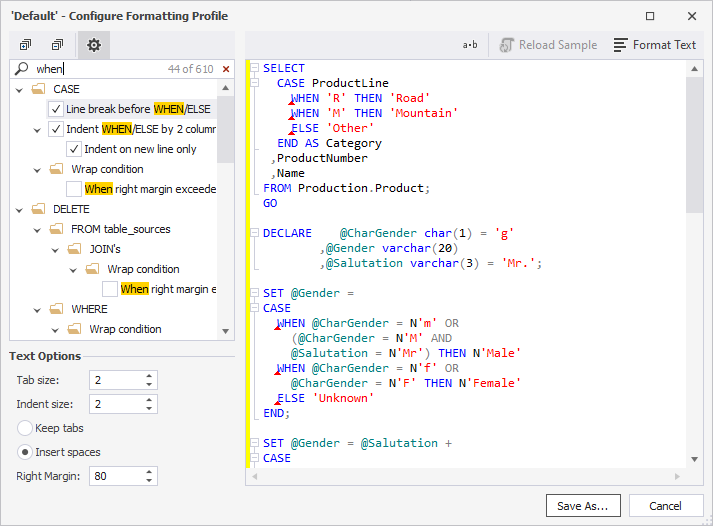Formatting options
Last modified: June 16, 2025
To access formatting options, go to the Tools menu and select Options. In the Options window that opens, go to Text Editor > Formatting.

As you can see general formatting options are grouped into three categories.
Formatting
Here you can select how your code will be formatted: immediately on paste or after you add a delimiter to a completed statement.
The Right Margin option allows the user to specify the code line length in symbols.
Note
Right Margin is a base point for formatting rules applicable for different statements, for example, Wrap condition when the margin is exceeded and Single line when the margin is not exceeded.
Notifications
In the Notifications group of options, you can select to display syntax errors in the Output window and whether to show or not the syntax error notification window.
Note
Some features are disabled and available in dbForge Studio for SQL Server only.
Formatting profiles
Formatting profiles comprise sets of rules for how to layout your SQL. In order to configure formatting options or rules, do the following:
- In the Tools menu, click Options.
- In the Options window, go to Formatting > Profiles.
- Choose one of the predefined formatting profiles and click Open Selected to modify it. Alternatively, you can create a new profile by clicking Create New.
- Edit formatting options in the left-hand pane.
- Click Save As and enter a name and a path to your newly configured profile.
- Click OK.
Here, you will find the list of predefined formatting profiles, as well as the ways to customize them.
Every formatting profile has a number of rules.

Options are grouped mainly by the statement. Each group has a set of such options as Line Breaks, Indentation, and Insert Spaces.
Changes in the default state of options and their influence on statement formatting can be viewed on the right-hand pane Formatting preview.
Search for statements or options can be conducted via the option search box.

In the Search box, you can use the following keyboard shortcuts:
- Ctrl+A to select all.
- Ctrl+Left Arrow (←) to move the caret to the beginning of the word.
- Ctrl+Right Arrow (→) to move the caret to the end of the word.
- Ctrl+Shift+Left Arrow (←) to select text from the current caret position to the beginning of the current word and move the caret to the beginning of the word.
- Ctrl+Shift+Right Arrow (→) to select text from the current caret position to the end of the current word and move the caret to the end of the word.
- Ctrl+Backspace to delete the word to the left of the cursor.
Text options
Text options allow indicating the Tab size and the Indent size in symbols. Here you can also select to Keep tabs and Insert Spaces, as well as specify the Right margin.
Tab size specifies the width of a tab character in whitespaces.
Indent size defines how many whitespaces will be put in the indented line start.
The indentation is performed with tabs or spaces depending on which option is selected - Keep tabs or Insert Spaces.
To hide/show the Text options pane, click the gear-wheel icon in the menu of the Edit Formatting Profile window.
Want to find out more?
Overview
Take a quick tour to learn all about the key benefits delivered by Data Compare for SQL Server.
All features
Get acquainted with the rich features and capabilities of the tool in less than 5 minutes.
Request a demo
If you consider employing this tool for your business, request a demo to see it in action.
